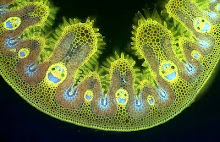I have to admit that I'm not a huge fan of broccoli as a vegetable to eat, but nothing comes close to Romanesco broccoli - in my estimation - as an vegetable to just look at. The geometrical precision of the curd, which is a mutant inflorescence made up of repeated spirals of flower buds, most of which never open, is almost hypnotic if you stare at it for long enough (especially if you've had a glass or two of wine beforehand). If you dissect one of these flower heads you soon discover that the pattern of spirals, so obvious in the whole structure, is repeated in the individual florets and again in the sub-florets (double-click on the picture for a larger image that makes this more apparent). This is what mathematicians call a fractal - each constituent part is a subset of the whole. This isn't the only plant to conform to fractal geometry - fern fronds follow the same mathematical logic.
The curds of cauliflowers and broccoli, which are naturally mutated inflorescences, are composed of buds that have proliferated to such an extent that they tend to rot away before they can flower. When I was a young postgraduate student I worked in a vegetable research station where new varieties of cauliflower were bred and was taught the technique of producing cauliflower flowers, so that they could be cross pollinated. The trick was to dissect a cauliflower into its individual flowers (scions) and to graft each of these onto a well developed decapitated cabbage seedling as a stock. Once stock and scion had united the relatively small number of buds in the dissected piece of curd would flower and the flowers could be cross pollinated. So next time you are tucking into cauliflower cheese, spare a though for the horticultural skills of the plant breeders who bred your cauliflower. GM technology may be clever and sophisticated, but greenfingers are still sometimes needed in crop breeding.














